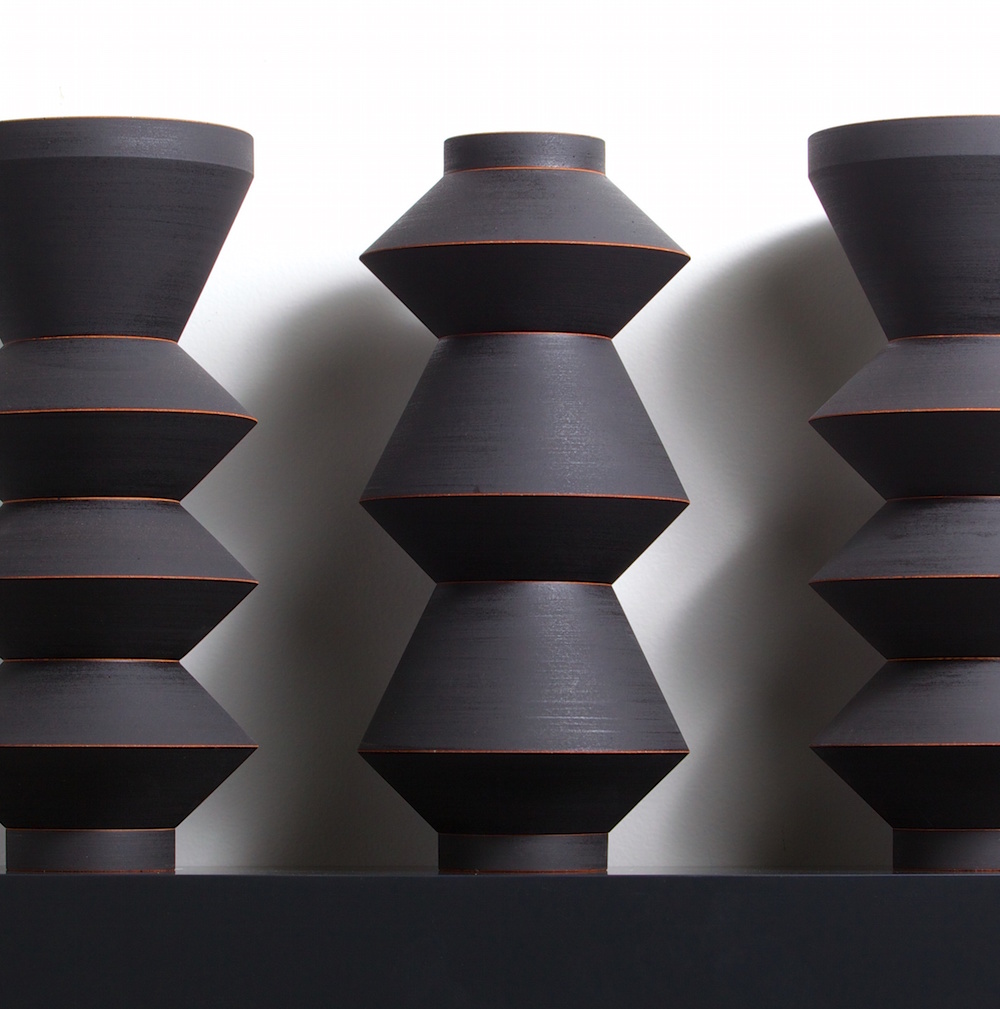Martin Smith is a major figure in 21st-century ceramics. Not only does his work retain contemporary relevance after nearly five decades, but his sixteen-year tenure as Professor of Ceramics and Glass at the Royal College of Art, London has been immensely influential, a key player in the College’s rise to leading design innovation today. Now that he has resigned that post we can look forward to more art. His output has been sparse over the last decade.

The exhibition Red and Black with Blue and Yellow at Marsden Woo (London, November 18 – December 19, 2015) is, in a sense, a coming out party. He has created three interrelated groups of work that seek to mathematically deconstruct the familiar ceramic archetypes of the bowl, the vase and the plate. As the gallery points out:
With reference to the ceramics of Ancient Greece, Smith primarily uses the color black on his vases and bowls. This is then removed in key areas to reveal the red of the terracotta from which they are made.
Vases are assembled as triptych groups on shelves, the spaces between as significant as the forms themselves. Multi-plate wall installations explore not only the moiré effects of linear interference, but also the optical interference of color when two or more color systems interact.


In essence they are a distillation of weight (heavy), red lines (quietly revolving) and volume (rising geometry). His work has always had an architectonic and so they read both as pots and as models for new age towers whose purpose is rendered ominous by the dense black light-devouring matte surface.


The bowls are different and I want to parse this distinction carefully. Pots can be art as part of the tradition of pottery itself. Sculptural without being sculpture. Hans Coper is a perfect example. But there is a second kind of vessel that takes pottery and a starting point and ends up in the sculpture camp. That is more true of Smith’s bowls than his tall vessels without either one being lesser. The bowls are not pots anymore except in inspiration, they have become more about sculpture. I know this is going to cause confusion and rebuke. Some will read this as devaluing pottery. But the distinction is real and common enough.


The bowls inhabit mass. The volume is compositionally crucial to the dynamism of the work, and subject remains a bowl but it reads as a sculpture. Indeed its transference into a bronze edition would be seamless and one can imagine scaled up gigantically as a public work, which would not work for the vessels. A reminder: the one is not “better” than the other. But they are different as is the manner in which we read them.

The visual juxtaposition of Smith’s pared-down sculptural vases and bowls with the complex graphic prints of his wall-based plate pieces sees the artist create an environment within which the viewer can experience sensations of perception and space.
While I have no problem with any series of works, albeit with the preference for the tall vessel form and the black bowls, the plates are distracting and needed to be shown in a separate space. Intellectually they taking the same path but visually there is little chemistry. That said, with power invested in me by the Internet, I have created a separate post for these works. Minimalism is adverse to visual noise and so his elegant triptychs live better alone. Even the blue bowls, while companionable, do not create the same sense of dynamic silence. The pots have enough clutter to deal coming from the gallery architecture itself.

Smith still had ties to alma mater and has recently taken on a new role as Senior Research Fellow at the RCA, exploring the ‘Potential of the Digitally Printed Ceramic Surface’. He has recently designed the domestic-style gallery space for the Anthony Shaw Collection in York Art Gallery. And he is making more art and other projects on the way.
Garth Clark is Chief Editor of cfile.daily.



Add your valued opinion to this post.